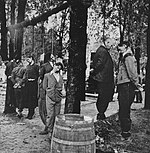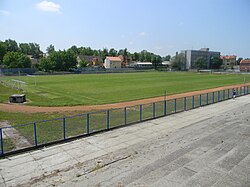Pančevo (Serbian Cyrillic: Панчево, pronounced [pâːntʃeʋo]; German: Pantschowa; Hungarian: Pancsova; Romanian: Panciova; Slovak: Pánčevo) is a city and the administrative center of the South Banat District in the autonomous province of Vojvodina, Serbia. It is located on the shores of rivers Tamiš and Danube, in the southern part of Banat region. Since the 2022 census 115,454 people have been living in the Pančevo administrative area. Pančevo is the third largest city in Vojvodina and the seventh largest in Serbia by population.
Pančevo was first mentioned in 1153 and was described as an important mercantile place. It gained the status of a city in 1873 following the disestablishment of the Military Frontier in that region. For most of its period, it was the part of the Kingdom of Hungary and after 1920 it became part of the Kingdom of Serbs, Croats and Slovenes, which was renamed in 1929 to Yugoslavia. Since then with one interruption it was part of several Yugoslav states and after the dissolution of the latest in 2003, it is part of its successor state, Serbia. Pančevo is notable for being multi-ethnic, Serbs (and Germans until 1945) have been the dominant ethnic group since the 16th century and since 2011 they compose 80% of the total population of the city.
Pančevo is a city with rich cultural events and monuments, and in the past, it also used to be a filming location for many national and international movie productions. Since 2003 an international and multi-cultural carnival has been organized in the city. It is also the main economic center of the South Banat region and its economy is also mostly tied up to Belgrade's economy. HIP factory is located in Pančevo as well as UTVA which was heavily damaged during the bombing of Yugoslavia in 1999. Pančevo is also well known for its brewery and silk factory which were founded in the early 18th century, and as well as the light bulb factory which are all now defunct. Pančevo is also home to many historical objects, museums and parks.











